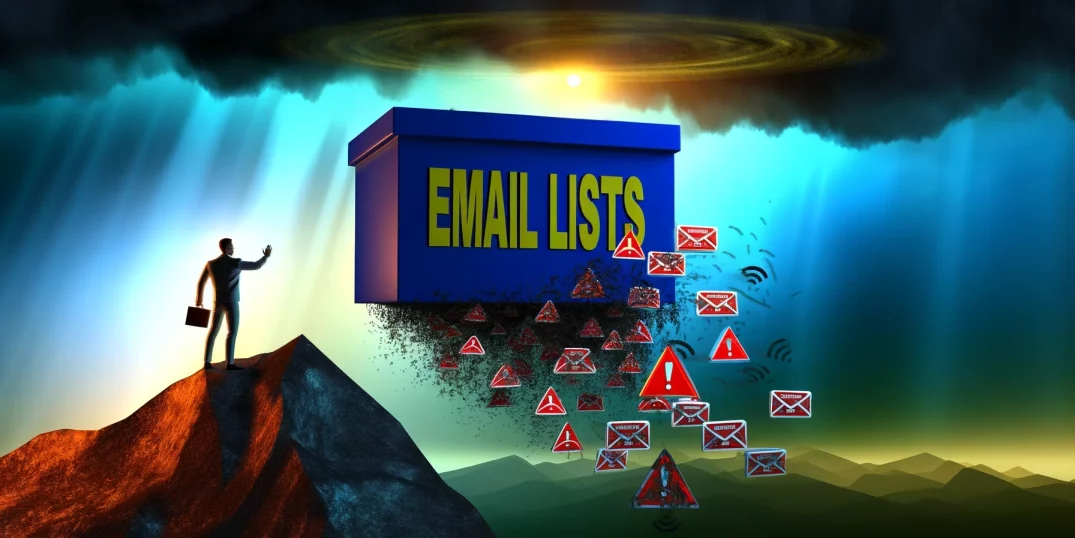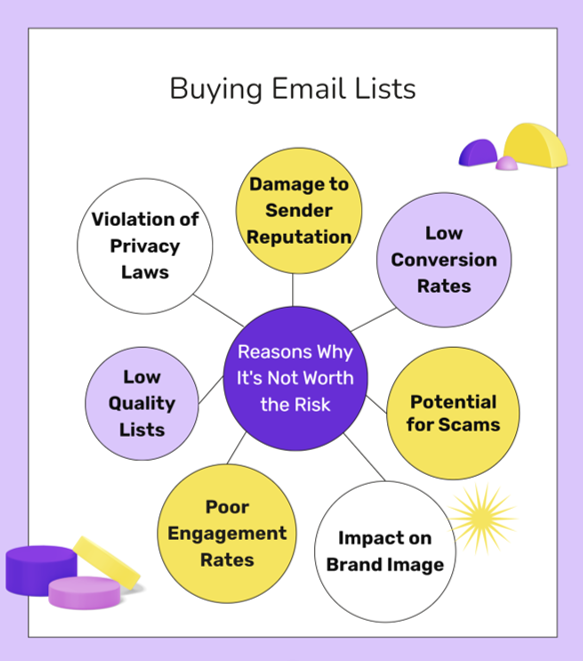- Home
- Email Tips and Tricks
- Buying Email Lists: Why ItR ...

✨ Key takeaways:
⭐ Buying email lists violates privacy laws like the GDPR and can result in legal penalties.
⭐ Purchased contacts show poor engagement and extremely low open and click rates.
⭐ Unsolicited emails damage sender reputation and increase the risk of blacklisting.
⭐ Many bought lists are outdated, irrelevant, or acquired through unethical methods.
⭐ Sending unsolicited emails harms brand image and undermines consumer trust.
⭐ Effective alternatives include lead magnets, SEO, webinars, and social media sign-ups.
Let’s be honest: the option of simply buying an email list does look appealing. Instead of spending months painstakingly encouraging people to subscribe, you can make one quick purchase – and your problems are solved. Or so it may seem.
A closer look at the practice of purchasing email lists paints a different – and much less appealing – picture. A picture fraught with legal pitfalls and diminishing returns.

The idea of buying email lists might appear as a fast track to expanding your reach. But it’s a path riddled with unnecessary risk
Statistics explain further why strategy is ill-advised. For instance, research shows that emails from purchased lists have significantly lower open rates – often as low as 1% — compared to an average open rate of 20-30% for organically grown lists.
Organically grown email lists are made up of subscribers who “volunteered” to receive emails from you – this translates into higher engagement and open rates. Purchased email lists, on the other hand, include random people who have not shown the slightest interest in your brand or what it has to offer. This means lower open rates and an almost non-existent engagement.
And this is the fundamental truth of digital marketing: the quality of your audience matters far more than the quantity.
1. Violation of Privacy Laws
Purchasing email lists can be a direct violation of privacy laws. This is particularly true for jurisdictions governed by regulations like the General Data Protection Regulation (GDPR) in Europe.
The GDPR, for example, mandates that you receive explicit consent from people before sending them your emails. This means that your potential subscribers need to actively opt in to be on your email list.
If you buy an email list, you will most likely be acquiring the contacts of people who have not given consent. As a result, you will be in violation of the related regulations.
Non-compliance can leave you with hefty fines and legal repercussions. Worse even, it can damage your company’s reputation and financial health.
2. Poor Engagement Rates
Another issue you will be dealing with are low engagement rates.
As these lists are often composed of people who haven’t volunteered their contact information, you will be dealing with an audience that is unengaged from the start. So, the emails you send to these addresses will most likely be ignored, deleted, or sent to the spam folder.
This lack of engagement is not only bad from a marketing standpoint. It is also a big waste of resources that could have been used on building and nurturing an organic email list.
3. Damage to Sender Reputation
The integrity of your reputation as a sender is very important in email marketing. Email service providers (ESPs) monitor various metrics – and this includes how often emails are marked as spam. If you send unsolicited emails to a purchased list, you have a substantially higher chance of having your emails marked as spam. This will signal to ESPs that you may be a spammer – and your domain may get blacklisted.
Once you are blacklisted as a sender, it will become increasingly difficult for any of your emails to reach their destination. This will have a long-lasting effect on your email marketing efforts, complicating the situation further.
4. Low Conversion Rates
One of the nastiest side-effects of a purchased email list are low conversion rates. The main reason behind them is the fact that there is no pre-existing relationship or interest between you and the people you are emailing. Imaging receiving an email from someone you don’t know? Your desire to engage with the content in such an email would be minimal.
This lack of engagement translates directly into lower conversion rates, as the recipients have no vested interest or familiarity with the sender’s products or services. In essence, even if the emails successfully bypass spam filters and land in the inbox, their chances of sparking interest and action are still considerably low.
5. Potential for Scams and Low-Quality Lists
Another considerable risk in purchasing email lists lies in the quality and legitimacy of the lists themselves. The market for buying email lists is fraught with scams and low-quality offerings. Many vendors sell outdated, irrelevant, or even fabricated email addresses. The lack of quality control in these lists means that a significant portion of the emails might be to inactive or non-existent accounts, or worse, to individuals who have no interest in the sender’s niche.
Furthermore, there’s an ethical consideration as well; some of these lists are compiled through dubious means, potentially breaching privacy laws and ethical standards. Engaging in transactions with such vendors not only risks your campaign’s effectiveness but also exposes your business to legal and ethical liabilities.
6. Impact on Brand Image
Perhaps one of the most overlooked yet significant impacts of buying email lists is the potential damage to the brand’s image. When a company sends unsolicited emails, it risks being perceived as intrusive or disrespectful of individual privacy. This perception can be particularly damaging in an era where consumers are increasingly concerned about their data and privacy.
Receiving unsolicited emails can lead recipients to form a negative view of the brand, associating it with spam-like behavior. This negative perception can be hard to reverse and may alienate potential customers who might have otherwise been interested in the brand if approached in a more ethical and consensual manner.
Alternatives to Buying Lists
If you are looking for an alternative to buying email lists, you’ll be pleased to know that there are quite a few effective strategies to organically grow your email audience.
- Create really valuable content. Work on developing engaging and informative content that drives visitors to your website. Your content should solve a problem or offer valuable insight for your readers.
- Use social media. Leverage your social media platforms to get more sign-ups for your email list. Share snippets of your valuable content and direct followers to your website for full access.
- Host events and webinars. Organize events and webinars that require attendees to register via email. This is not only a great way to build an email list but also to engage your readers with valuable live content.
- Apply SEO strategies. To increase organic traffic, make sure to optimize your website for search engines. The more people land on your website, the more opportunities for email sign-ups you will have.
- Leverage lead magnets. The one strategy that always helps increase email sing-ups is offering freebies: ebooks, whitepapers, or discount codes in exchange for email subscriptions.
- Engage in partnership and affiliate marketing. Initiate collaborations with other brands or influencers. This is an effective way to expand your reach and encourage new audience to sign up for your emails.
For a detailed exploration of these strategies, including practical tips on how to implement them effectively, please refer to our comprehensive article on the blog: Email Lists Unlocked: Key Strategies for Growing Your Marketing Reach
To Sum Up
While it may be tempting to buy email lists, this shortcut to expand reach is fraught with significant drawbacks. It may jeopardize your compliance with privacy laws and severely impact engagement and conversion rates. At a closer look, the risks of damaging your brand’s reputation and facing legal penalties far outweigh any potential benefits.
Here’s a smarter and more sustainable approach: instead of investing money and other resources into buying email lists, invest into organically growing an email list. This method ensures that the audience is genuinely interested in your offerings, leading to higher engagement, better conversion rates, and a positive brand image. Strategies such as creating valuable content, utilizing social media, hosting events, implementing SEO, leveraging lead magnets, and engaging in partnership marketing are proven methods to build a robust and engaged email list.



